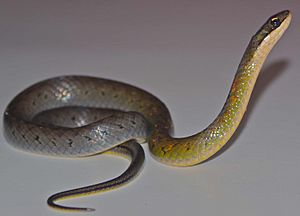Erythrolamprus epinephalus facts for kids
Erythrolamprus epinephalus is a species of snake in the Colubridae family. It is endemic to South America. This amazing snake, first described by Edward Drinker Cope in 1862, is famous for a special ability: it seems to be immune to the strong toxins found in the skin of the Golden poison dart frog, which it often hunts and eats.
Quick facts for kids Erythrolamprus epinephalus |
|
|---|---|
 |
|
| Conservation status | |
| Scientific classification | |
| Genus: |
Erythrolamprus
|
| Species: |
epinephalus
|
| Synonyms | |
|
|
- Common name: fire-bellied snake
Contents
About the Fire-Bellied Snake
The Erythrolamprus epinephalus is a type of snake that belongs to a large group called Colubridae. This family includes many different kinds of snakes found all over the world. The fire-bellied snake gets its common name from its belly, which often has bright, warm colors.
Where Does It Live?
This snake lives only in South America. It can be found in various habitats across the continent. Snakes like the fire-bellied snake need specific environments to thrive, such as forests or areas with plenty of hiding spots and food.
What Does It Eat?
One of the most interesting things about the fire-bellied snake is its diet. It preys on amphibians, especially frogs. What makes it unique is its ability to eat the Golden poison frog, which is one of the most poisonous animals on Earth.
How It Handles Poison
The Golden poison frog produces a very strong toxin on its skin. This toxin is usually deadly to most animals that touch or try to eat the frog. However, the fire-bellied snake has developed a special resistance to this poison. Scientists are still studying exactly how it does this. This adaptation allows the snake to hunt and eat these dangerous frogs without getting sick.
Who Discovered This Snake?
The Erythrolamprus epinephalus was first officially described in 1862 by an American scientist named Edward Drinker Cope. Cope was a very important paleontologist and zoologist who studied many different animals, including snakes, fish, and even dinosaurs. His work helped us understand more about the natural world.
Conservation Status
The conservation status of Erythrolamprus epinephalus is listed as "Least Concern" by the IUCN. This means that, for now, the snake is not considered to be in danger of extinction. However, it is always important to protect natural habitats to ensure all species can continue to thrive.
See also
 In Spanish: Culebra de pantano para niños
In Spanish: Culebra de pantano para niños


